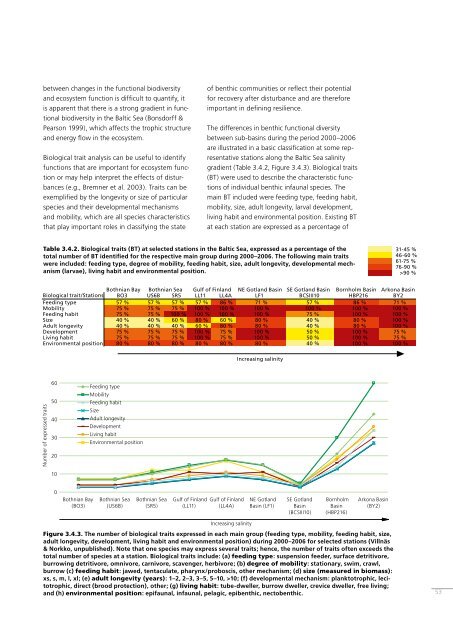BSEP116B Biodiversity in the Baltic Sea - Helcom
BSEP116B Biodiversity in the Baltic Sea - Helcom
BSEP116B Biodiversity in the Baltic Sea - Helcom
Create successful ePaper yourself
Turn your PDF publications into a flip-book with our unique Google optimized e-Paper software.
etween changes <strong>in</strong> <strong>the</strong> functional biodiversity<br />
and ecosystem function is difficult to quantify, it<br />
is apparent that <strong>the</strong>re is a strong gradient <strong>in</strong> functional<br />
biodiversity <strong>in</strong> <strong>the</strong> <strong>Baltic</strong> <strong>Sea</strong> (Bonsdorff &<br />
Pearson 1999), which affects <strong>the</strong> trophic structure<br />
and energy flow <strong>in</strong> <strong>the</strong> ecosystem.<br />
Biological trait analysis can be useful to identify<br />
functions that are important for ecosystem function<br />
or may help <strong>in</strong>terpret <strong>the</strong> effects of disturbances<br />
(e.g., Bremner et al. 2003). Traits can be<br />
exemplified by <strong>the</strong> longevity or size of particular<br />
species and <strong>the</strong>ir developmental mechanisms<br />
and mobility, which are all species characteristics<br />
that play important roles <strong>in</strong> classify<strong>in</strong>g <strong>the</strong> state<br />
of benthic communities or reflect <strong>the</strong>ir potential<br />
for recovery after disturbance and are <strong>the</strong>refore<br />
important <strong>in</strong> def<strong>in</strong><strong>in</strong>g resilience.<br />
The differences <strong>in</strong> benthic functional diversity<br />
between sub-bas<strong>in</strong>s dur<strong>in</strong>g <strong>the</strong> period 2000–2006<br />
are illustrated <strong>in</strong> a basic classification at some representative<br />
stations along <strong>the</strong> <strong>Baltic</strong> <strong>Sea</strong> sal<strong>in</strong>ity<br />
gradient (Table 3.4.2, Figure 3.4.3). Biological traits<br />
(BT) were used to describe <strong>the</strong> characteristic functions<br />
of <strong>in</strong>dividual benthic <strong>in</strong>faunal species. The<br />
ma<strong>in</strong> BT <strong>in</strong>cluded were feed<strong>in</strong>g type, feed<strong>in</strong>g habit,<br />
mobility, size, adult longevity, larval development,<br />
liv<strong>in</strong>g habit and environmental position. Exist<strong>in</strong>g BT<br />
at each station are expressed as a percentage of<br />
Table 3.4.2. Biological traits (BT) at selected stations <strong>in</strong> <strong>the</strong> <strong>Baltic</strong> <strong>Sea</strong>, expressed as a percentage of <strong>the</strong><br />
total number of BT identified for <strong>the</strong> respective ma<strong>in</strong> group dur<strong>in</strong>g 2000–2006. The follow<strong>in</strong>g ma<strong>in</strong> traits<br />
were <strong>in</strong>cluded: feed<strong>in</strong>g type, degree of mobility, feed<strong>in</strong>g habit, size, adult longevity, developmental mechanism<br />
(larvae), liv<strong>in</strong>g habit and environmental position.<br />
31-45 %<br />
46-60 %<br />
61-75 %<br />
76-90 %<br />
>90 %<br />
Bothnian Bay Bothnian <strong>Sea</strong> Gulf of F<strong>in</strong>land NE Gotland Bas<strong>in</strong> SE Gotland Bas<strong>in</strong> Bornholm Bas<strong>in</strong> Arkona Bas<strong>in</strong><br />
Biological trait/Stations BO3 US6B SR5 LL11 LL4A LF1 BCSIII10 HBP216 BY2<br />
Feed<strong>in</strong>g type 57 % 57 % 57 % 57 % 86 % 71 % 57 % 86 % 71 %<br />
Mobility 75 % 75 % 75 % 100 % 100 % 100 % 100 % 100 % 100 %<br />
Feed<strong>in</strong>g habit 75 % 75 % 100 % 100 % 100 % 100 % 75 % 100 % 100 %<br />
Size 40 % 40 % 60 % 80 % 60 % 80 % 40 % 80 % 100 %<br />
Adult longevity 40 % 40 % 40 % 60 % 80 % 80 % 40 % 80 % 100 %<br />
Development 75 % 75 % 75 % 100 % 75 % 100 % 50 % 100 % 75 %<br />
Liv<strong>in</strong>g habit 75 % 75 % 75 % 100 % 75 % 100 % 50 % 100 % 75 %<br />
Environmental position 80 % 80 % 80 % 80 % 80 % 80 % 40 % 100 % 100 %<br />
Increas<strong>in</strong>g sal<strong>in</strong>ity<br />
31 45 %<br />
Number of expressed traits<br />
60<br />
50<br />
40<br />
30<br />
20<br />
Feed<strong>in</strong>g type<br />
Mobility<br />
Feed<strong>in</strong>g habit<br />
Size<br />
Adult longevity<br />
Development<br />
Liv<strong>in</strong>g habit<br />
Environmental position<br />
10<br />
0<br />
Bothnian Bay<br />
(BO3)<br />
Bothnian <strong>Sea</strong><br />
(US6B)<br />
Bothnian <strong>Sea</strong><br />
(SR5)<br />
Gulf of F<strong>in</strong>land<br />
(LL11)<br />
Gulf of F<strong>in</strong>land<br />
(LL4A)<br />
NE Gotland<br />
Bas<strong>in</strong> (LF1)<br />
SE Gotland<br />
Bas<strong>in</strong><br />
(BCSIII10)<br />
Bornholm<br />
Bas<strong>in</strong><br />
(HBP216)<br />
Arkona Bas<strong>in</strong><br />
(BY2)<br />
Increas<strong>in</strong>g sal<strong>in</strong>ity<br />
Figure 3.4.3. The number of biological traits expressed <strong>in</strong> each ma<strong>in</strong> group (feed<strong>in</strong>g type, mobility, feed<strong>in</strong>g habit, size,<br />
adult longevity, development, liv<strong>in</strong>g habit and environmental position) dur<strong>in</strong>g 2000–2006 for selected stations (Villnäs<br />
& Norkko, unpublished). Note that one species may express several traits; hence, <strong>the</strong> number of traits often exceeds <strong>the</strong><br />
total number of species at a station. Biological traits <strong>in</strong>clude: (a) feed<strong>in</strong>g type: suspension feeder, surface detritivore,<br />
burrow<strong>in</strong>g detritivore, omnivore, carnivore, scavenger, herbivore; (b) degree of mobility: stationary, swim, crawl,<br />
burrow (c) feed<strong>in</strong>g habit: jawed, tentaculate, pharynx/proboscis, o<strong>the</strong>r mechanism; (d) size (measured <strong>in</strong> biomass):<br />
xs, s, m, l, xl; (e) adult longevity (years): 1–2, 2–3, 3–5, 5–10, >10; (f) developmental mechanism: planktotrophic, lecitotrophic,<br />
direct (brood protection), o<strong>the</strong>r; (g) liv<strong>in</strong>g habit: tube-dweller, burrow dweller, crevice dweller, free liv<strong>in</strong>g;<br />
and (h) environmental position: epifaunal, <strong>in</strong>faunal, pelagic, epibenthic, nectobenthic. 53

















